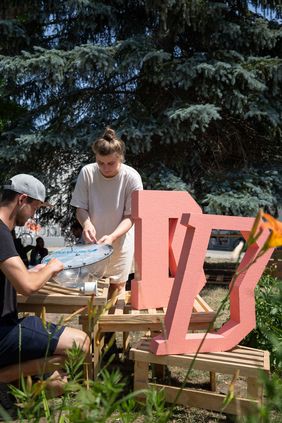»Ein Material, das auch in Zukunft funktioniert« [»A material that will also work in the future«] – students from the Bauhaus-Universität Weimar present alternatives to conventional concrete
Many natural resources are scarce and may become even scarcer in the future. Against this backdrop, students and instructors from the Faculty of Art and Design at the Bauhaus-Universität Weimar are exploring the use of sustainable materials in product design. In their semester project, young product design students Julia Huhnholz and Friedrich Gerlach investigated how sandstone-like biocement can be produced and processed. During the »summaery2019«, visitors are warmly invited to explore items made from this sustainable material and to learn about possible uses.
»At the start of our project, we examined lots of different materials and their possible uses in product design. We came across an interesting material: biocement«, Friedrich Gerlach reports. Biocement is a type of sandstone that can be produced using bacteria and a solution of urea and calcium chloride. So far, however, sandstone produced using bacteria has rarely been used. The advantages of the material are obvious: the microbial production means the natural stone is unique compared to other mineral materials. »Any type of sand can be used for processing. Unlike fired materials, sandstone solidifies at low temperatures and low pressure, i.e. with minimal energy consumption. The natural, low-energy production process makes its creation very sustainable«, Julia Huhnholz explains. The material also has the potential to replace concrete. The students explain the approach for their project, which was supervised by Prof. Dr. Jan Willmann, visiting scientist Uli Budde and Michael Braun: »In light of the growing scarcity of resources, it is important for us to use sustainable materials that will also work in the future«. Interested parties are warmly invited to explore the work outcomes of the aspiring product designers at the »summaery2019« and to learn more about the innovative concrete alternative.
Project supervisors:
Jun.-Prof. Dr. Jan Willmann, visiting professor Uli Budde, M.A. Michael Braun
Cooperations:
Institute of Microbiology – Friedrich Schiller University Jena, Friends of the Bauhaus-Universität Weimar e. V.
Contact:Romy Weinhold (Press and Public Relations Officer, Faculty of Art and Design) will gladly answer any questions (Tel.: +49 (0)03643 / 58 11 86; romy.weinhold[at]uni-weimar.de).


